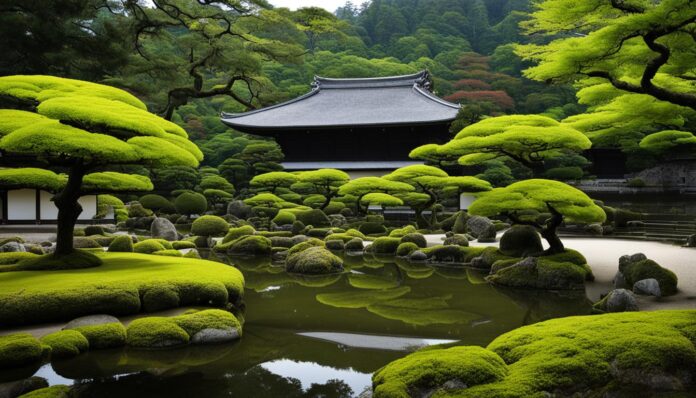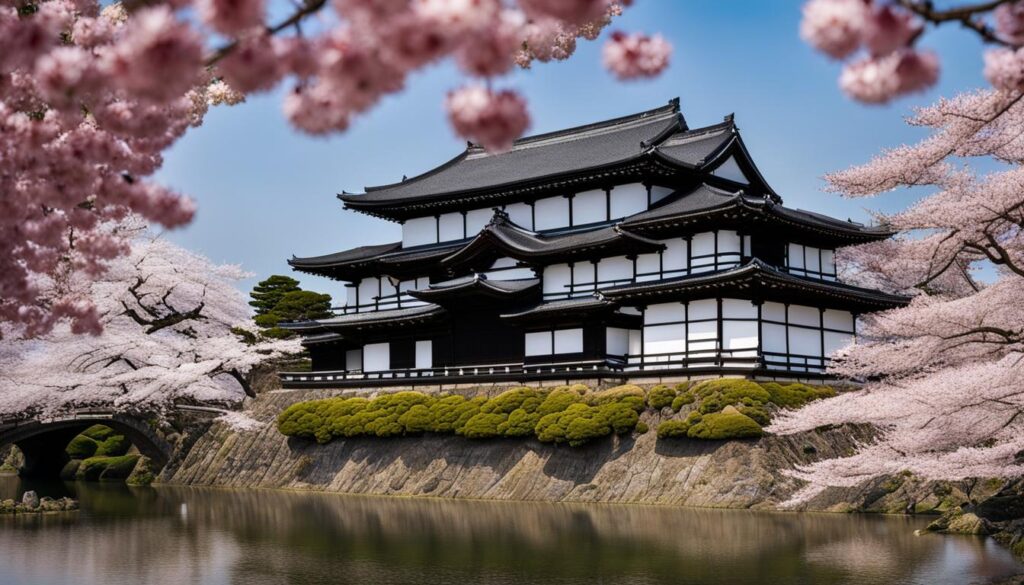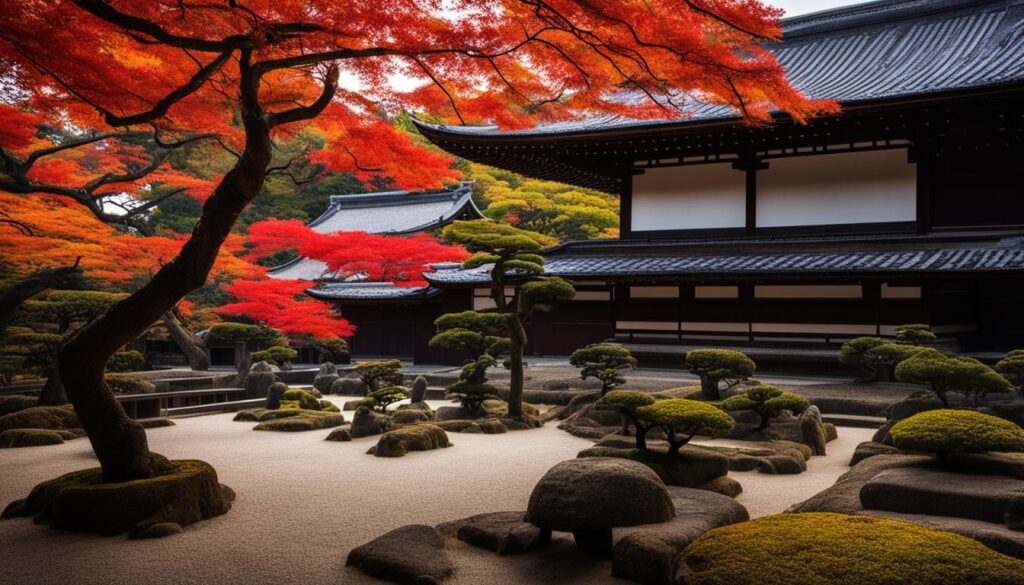When planning a trip to Kyoto, Kiyomizu-dera is most likely at the top of your must-see list. While this UNESCO World Heritage site is no doubt breathtakingly beautiful, Kyoto is also home to several other temples and shrines that are equally as magnificent and rich in history and culture.
Join us on a journey to discover must-see temples and shrines in Kyoto beyond Kiyomizu-dera. From the iconic Fushimi Inari Taisha Shrine with its thousands of torii gates to the Zen rock garden of Ryoan-ji Temple, Kyoto offers a range of cultural landmarks that are sure to leave you in awe.
Our Kyoto shrine guide will take you on an adventure through history and spirituality, as you explore the hidden gems of Kyoto’s spiritual landmarks. Embark on an unforgettable journey and discover Kyoto’s famous temples and shrines that have stood the test of time.
The Majestic Fushimi Inari Taisha Shrine
If you’re in Kyoto, a visit to the Fushimi Inari Taisha Shrine is a must. Located on Mount Inari, this iconic shrine is renowned for its thousands of vibrant red torii gates forming a stunning pathway through the mountains.
The shrine is dedicated to Inari, the Shinto god of rice and fertility, and was founded in the eighth century. As you approach the shrine, you will notice statues of foxes scattered around the area. In Japanese folklore, foxes are believed to be messengers of the god Inari, and they symbolize good fortune and success.
One of the best parts of visiting the Fushimi Inari Taisha Shrine is the serene forested trails that await you. The trails are lined with smaller shrines and statues, where locals come to pray for good fortune and success in their businesses. Along the way, you’ll also witness breathtaking views of Kyoto city.
Make sure to wear comfortable shoes as the trail can be lengthy, and don’t forget to bring your camera to capture the stunning landscape.
The Serene Kinkaku-ji Temple
When you visit Kyoto, the Kinkaku-ji Temple is a must-see attraction besides Kiyomizu-dera. This UNESCO World Heritage site, also known as the Golden Pavilion, is a stunning example of traditional Japanese architecture. The temple’s two upper floors are covered with gold leaf, and the surrounding gardens feature serene ponds and meticulously crafted structures.
Take a stroll around the temple grounds and enjoy the peaceful Zen gardens that symbolize the harmony between humans and nature. The historic site dates back to the 14th century and was initially built as a retirement villa for a shogun. After his death, the villa was converted into the temple and opened to the public.
The Kinkaku-ji Temple is a recommended Kyoto attraction that attracts millions of visitors each year. Make sure to take your time exploring the temple grounds and learning about the fascinating history behind this cultural landmark.
“The temple has a tranquil atmosphere that makes you forget about the hustle and bustle of everyday life. The gardens are impeccably maintained and a perfect example of the beauty and harmony of Japanese aesthetics.”
Interesting facts about Kinkaku-ji Temple
| Fact | Detail |
|---|---|
| Architectural Style | Traditional Japanese Zen Style |
| History | Built in 1397 as a retirement villa for shogun Ashikaga Yoshimitsu and later converted into a temple after his death |
| Location | 1 Kinkaku-ji-cho, Kinugasa, Kita-Ku, Kyoto, Japan |
| Garden Features | Ponds, islands, rock formations, and a tea house |
| Visitor information | Open daily from 9 am to 5 pm. Admission fee: 400 yen for adults, 300 yen for children. |
The Enchanting Ginkaku-ji Temple
When it comes to Kyoto’s cultural landmarks, Ginkaku-ji Temple is a must-see attraction beyond Kiyomizu-dera. Also known as the Silver Pavilion, this Zen temple showcases stunning architecture and serene gardens that will leave you breathless.
The temple’s garden is an exquisite example of refined Japanese design, with its meticulously arranged sand and rock formations. Take a leisurely stroll along the Philosopher’s Path, a picturesque trail that runs alongside a peaceful canal and offers stunning views of the temple and surrounding nature.
If you are interested in history, Ginkaku-ji Temple’s rich legacy will fascinate you. Built by shogun Ashikaga Yoshimasa in the late 1400s, the temple was originally intended to be covered in silver leaf, just like its counterpart, the Golden Pavilion (Kinkaku-ji). Despite being unfinished, the temple stands today as a testament to the aesthetic ideals cherished during the Muromachi period.
Make sure to take your time exploring Ginkaku-ji Temple. The tranquil atmosphere and enchanting scenery will transport you to another world entirely. Don’t forget to snap a photo of the iconic Silver Pavilion with the serene pond in the foreground!
Visiting Information
| Opening hours | Every day from 8:30am to 5:00pm |
|---|---|
| Admission fee | 500 yen for adults, 300 yen for high school students, and 200 yen for children |
| Access | Take bus #5 or #17 from Kyoto Station and get off at Ginkaku-ji Michi bus stop. The temple is a 5-minute walk from the stop. Alternatively, you can take the Keihan Main Line to Ginkaku-ji Station and walk for 10 minutes to reach the temple. |
- Address: 2 Ginkakuji-cho, Sakyo-ku, Kyoto City
- Phone: +81 75-771-5725
- Website: http://www.shokoku-ji.jp/g_about.html
The Intricate Sanjusangen-do Temple
Experience the wonder of Sanjusangen-do Temple, one of the most historic temples in Kyoto, and home to a mesmerizing collection of 1,001 life-sized statues of Kannon, the Buddhist goddess of mercy. Walk through the temple’s atmospheric halls and admire the intricate artwork that spans centuries, from Kamakura to Edo periods.
The main hall is the longest wooden structure in Japan, measuring over 120 meters. It is a sight to behold, with its ornate details and traditional Japanese architecture. Witness the temple’s signature 13-meter tall, 1000-armed Kannon statue that stands in the center of the main hall, surrounded by 1,000 smaller Kannon statues.
Take a moment to appreciate the temple’s serene atmosphere, and learn about its fascinating history. This cultural landmark is sure to leave a lasting impression on your Kyoto itinerary.
Sanjusangen-do Temple Information:
| Location | 657 Sanjusangendo Mawaricho, Higashiyama Ward, Kyoto, Kyoto Prefecture 605-0941, Japan |
|---|---|
| Hours of Operation | Open daily from 8:00 am to 4:30 pm |
| Admission | Adults- ¥600, Children (under 15)- ¥300 |
| Access | Take bus #100 or #206 from Kyoto Station and alight at the “Sanjusangendo-mae” bus stop. Alternatively, it’s a 10-minute walk from Keihan Shichijo Station. |
The Historic Nijo Castle
Experience a touch of history at Nijo Castle, a UNESCO World Heritage site situated in central Kyoto, one of the most famous cultural landmarks in Japan. Built in the early 17th century, the castle is renowned for its elegant architecture, which reflects Japanese minimalism and remains an impressive testament to the era’s architectural finesse.
The Castle’s spacious external grounds are surrounded by stunning gardens that offer the opportunity to immerse yourself in the tranquility and nature of the Japanese aesthetic. Magnificent walkways, ponds, waterfalls, and blooming flowers are surrounding the castle, creating a serene atmosphere that is perfect for relaxation and meditation.
Now ranked as one of Japan’s best-preserved castles, Nijo is a must-visit on any Kyoto shrine guide. The castle’s rooms and halls are infused with intriguing and fascinating stories of the past that create a magical tale of its own. These include the famous Nightingale floor, which is designed to make a chirping sound when stepped on, allowing the room guards to easily detect intruders.
The castle has two main sections that complement the castle’s fortified architecture. The Honmaru Palace is filled with elaborately decorated, hand-painted walls and ceilings, while the Ninomaru Palace is where the shogun entertained special guests.
The Ninomaru Garden is a stunning landscape garden that creates an ideal spot to admire the beauty of the Japanese garden. The garden is landscaped naturally with a small hill that rises from the center with trees and shrubs forming a perfect symmetrical pattern.
Therefore, visiting Nijo Castle is an adventure to the past that should feature in your Kyoto religious shrine guide. This picturesque castle takes you on an unforgettable journey of discoveries and experiences that will leave an indelible mark on your memory.
The Enigmatic Ryoan-ji Temple
As you explore Kyoto’s temples and shrines, you cannot miss the Ryoan-ji Temple, renowned for its Zen rock garden that has intrigued visitors for centuries. The simplicity and harmony of the meticulously arranged stones are sure to captivate you, inviting you to contemplate the deeper meanings behind them. Sit in quiet contemplation, breathing in the serene atmosphere and feeling a sense of peace like no other.
An interesting fact about the rock garden is that it consists of 15 stones, arranged in such a way that no matter where you stand, you can only see 14 of them at once. It is believed that the garden represents the idea of infinity, where the final stone cannot be seen from the human viewpoint.
The temple itself is also a sight to behold, with its beautiful tatami rooms and stunning gardens. Dating back to the 15th century, Ryoan-ji is a designated National Treasure of Japan, a testament to its historical and cultural significance.
“The beauty of the rock garden lies not just in the intricacy of its design, but in the feeling of calm that it inspires in visitors”.
Make sure to add the enigmatic Ryoan-ji Temple to your list of recommended Kyoto attractions. Its tranquil beauty and cultural significance are sure to leave a lasting impression on you.
The Ethereal Byodo-in Temple
As you explore Kyoto’s spiritual landmarks, make sure to visit the Byodo-in Temple, a breathtaking example of Buddhist architecture and design. The temple’s iconic Phoenix Hall reflects beautifully on the tranquil pond, creating a serene atmosphere that will put you at ease.
Originally built as a villa in the Heian period, the Byodo-in Temple was later transformed into a Buddhist temple and now stands as a symbol of love and beauty. Its historical significance is apparent throughout the entire temple.
| Temple Features | Description |
|---|---|
| Phoenix Hall | The centerpiece of the temple, Phoenix Hall, is a stunning example of Buddhist design and architecture. |
| Amida Hall | Also known as the Western Precinct, the Amida Hall boasts intricately designed ceilings and a collection of unique statues. |
| Lotus Pond Garden | The Lotus Pond Garden is a picturesque example of Japanese garden design, featuring a serene pond and beautiful greenery. |
Don’t miss out on experiencing the Byodo-in Temple during your trip to Kyoto. The temple is a must-see landmark, showcasing the city’s rich cultural roots and making it clear why it’s considered one of the most famous temples in Kyoto.
Conclusion
As you can see, Kyoto is home to countless cultural landmarks and attractions that extend beyond the popular Kiyomizu-dera. By exploring the must-see temples and shrines listed in this guide, you’ll gain a deeper understanding and appreciation for the city’s rich history, stunning architecture, and spiritual essence.
Make sure to add these hidden gems to your Kyoto itinerary to create a truly memorable experience. Whether you’re interested in exploring historic temples, serene gardens, or learning about Kyoto’s fascinating culture, there’s something for every traveler in this vibrant city.
Take this shrine guide with you and discover the breathtaking beauty that lies beyond the beaten path. Kyoto is truly a city that will captivate your heart and leave you with unforgettable memories.

















































